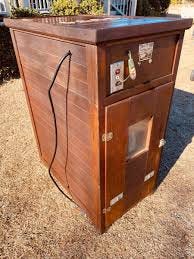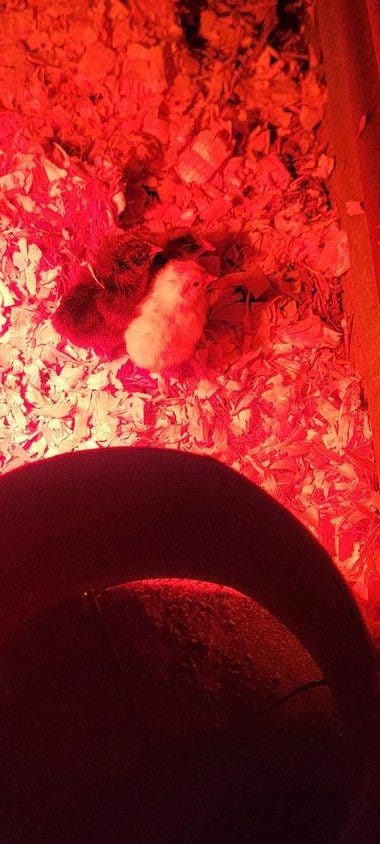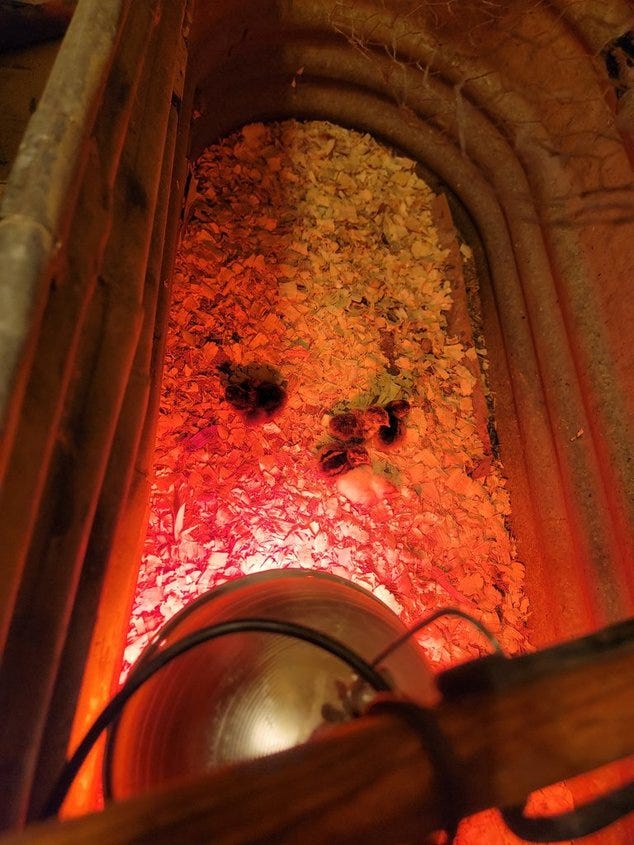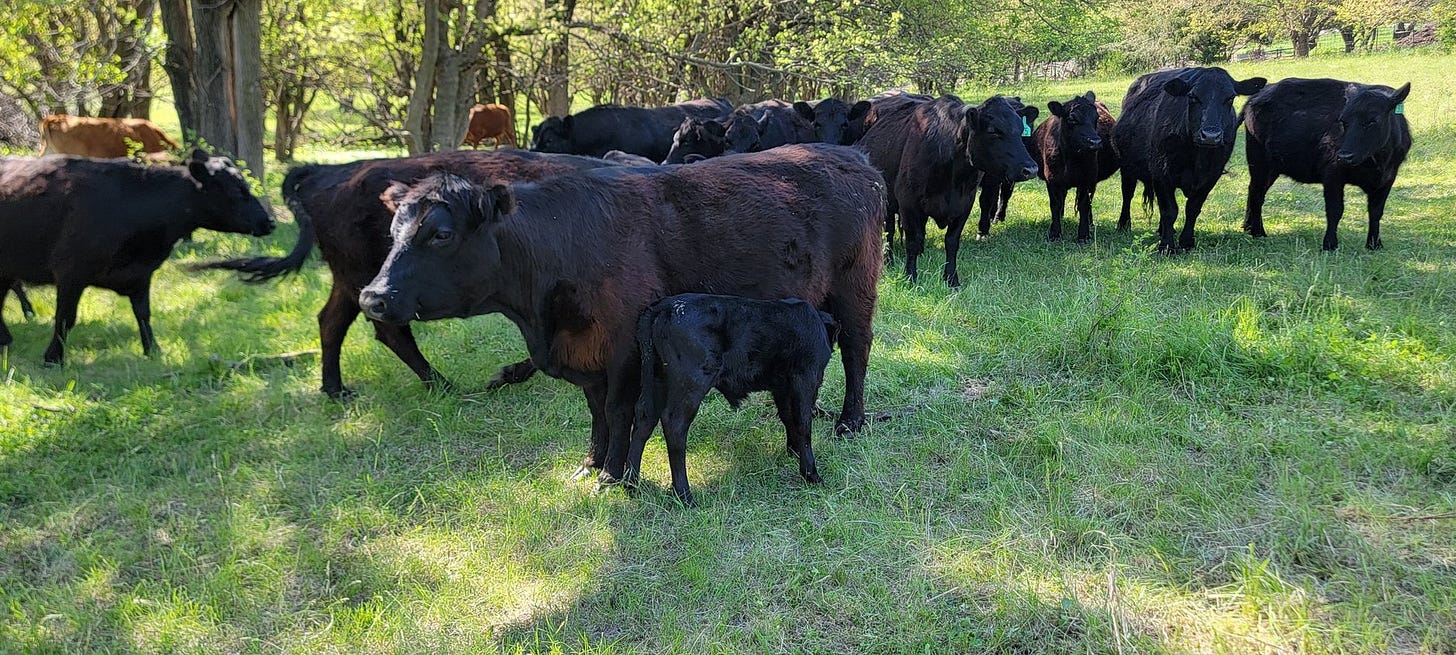I’m taking a small break form posting my political thoughts as I had mentioned in my May 1st substack things are getting busy here. Prepping for the world events that I foresee coming is in my opinion far more critical than me writing about my thoughts. Hopefully this will inspire and help those that want to do some basic homesteading to full fledged small time farming with cattle, turkeys and chickens.
Baby chicks are hatching. They hatched Saturday May 10th. out of 24 eggs collected 5 hatched. 19 were unfertile as after a week they made no progress. The rooster I used is 4 or 5 years old so that may have been the problem. Normally I get a 80-90% hatch rate on chicken eggs. At his point I will probably wait and see if the chicks I ordered come in and are healthy, Late May is the due date so a couple of weeks. I can always put a younger rooster in with the hens and try again. This group is a mix of various breeds, so it will be interesting what the colors will be. The ones I have coming in will be separated when I want to hatch again Spring 2026.
http://www.leggspeafowl.com/history-of-leahy-incubator.html
I have an old Leahy Manufacturing incubator, the above link has a short history of them.
I use a red light heat lamp for brooding. Yes they can be a fire hazard. I use the spring clamp then also a piece of baling wire as a back up. The regular light leads to pecking and the heat plates in my opinion do not keep it warm enough and heat space is limited. This water tank is 2x6x2 foot plenty of room to get close to the heat or get away from it, their choice. I’m a member of several chicken groups on facebook and people are using plastic tubs, large and small and their chicks are dying in huge numbers. They need heat, they need to cool off, the need room. Crowding leads to all sorts of problems, the ammonia from the manure is not good for them, crowding make that overwhelming. Once any animal gets lung problems its hit and miss as to how bad it gets.
We’ve also finally got started on the new coop. I am terrible at gauging level, we ended up moving far more dirt that I thought we would. I am also terrible at placing buildings. I want them to be multi-purpose so placement takes thought. This is a 10x20 and it is being built for a coop now but I am thinking to the future and it will be built so it can house atv’s mowers, and other odds and ends. I’ll keep updating the construction process as I have several ideas on what I want to do as far as doors and window placements. I will also more than likely run power to it at some point. Running a cord is just not a good option.
Cattle are out on pasture, that’s the good thing. The bad is we are again in a drought and if rain does not come and soon liquidation or hay feeding will require some hard thinking and a sharp pencil. This is my 10th year in this breeding program and the thought of liquidation is not pleasant but hay purchasing gets expensive quickly. These cows are calm, make wonderful beef, and are smaller so its more economical to purchase a side of beef. Today - May 12th 2025 boxed beef closed at $348.14 per hundred weight. These cattle weigh 400-500 lbs on the hook vs 800-1000 for other cattle. So a little bit of math shows while you will not receive as much meat the cost is more manageable.
https://usda.library.cornell.edu/concern/publications/9880vq97f This link has the USDA daily boxed beef cut out reports.
Purchasing a side of beef allows you to have your beef cut the way you like. Hamburger packaged in 1, 1.5 or 2 lbs. Steaks cut and packaged to your favorite thickness. Roasts cut to your size specifications, soup bones and tallow are also available. I get both, the soup bones for those cold winter days and fajita meat when ever you want, you just need to cut it up. I render my own tallow. Which I cover here:
Beef Tallow - The lost art of rendering and uses
Something that many of our grandmothers did is make beef tallow or pork lard. I remember “helping” my grandmother do this as a young lad. (I was fortunate as at 4 years old my grandparents moved fromt he farm to the city so they both brang their farm life with them where they could. By the time my siblings were old enough to remember they had mostly gr…
Its little wonder Longhorns have such a unique flavor profile. The three Longhorns I have were all eating weeds while the Dexter/Lowline Angus were in the grass and not interested in weeds.
Many “weeds” are more nutritious than grass.
https://onpasture.com/2015/03/02/eat-your-weeds/
What’s interesting about the weed research reviewed in this publication is that it’s not recent. Some of them date back to the 1970s. So, we’ve known that weeds are pretty nutritious for a long time. What we haven’t really understood as well is how animals choose what to eat. But thanks to research done more recently at Utah State University, we now know that animals choose first what their Moms and herd mates eat. They don’t like to experiment with new foods because, but when they do, they keep on eating it if it meets their requirements. (Here’s an article about Palatablity that explains this.) So, if no one your animal knows is eating a weed, and it has everything it needs, it won’t try the new weed and it won’t know that it’s tasty.
Longhorns are a scrappy cattle. If its green they will eat it, if its brown they will eat it. They are survivors. My brother and I ran a registered heard in the 1990’s All of our neighbors were losing calves to coyotes and dog packs, we lost none. Longhorns know how to use those horns and they are sharp. They are super protective of their young and herd mates in general.
The particular pasture the cattle are in right now is native grass for this area of Nebraska. It has cool season grasses invading it. Their are a couple ways to hurt cool season grasses so the native grass will compete. One is chemical herbicides - round up before green up in the spring, or atrazine. Atrazine is no longer allowed due to water pollution run off. Round Up is still used but I have not used it for 25+ years. It does a great job but even back then many were worried about what it does long term to the soil and our health. Another is fire, Fire weakens the root system, while I have considered fire I do not have a crew on this end of the state to help with it and if it got out of hand it could be ugly. The other is to let the cattle just beat it down to the ground and over graze it repeatedly in the spring. You just keep it beat down until late May. That is what I have been doing for years now. While it is effective for the season it never does have results like Round Up or atrazine.
With chicks coming in, turkey poults not far behind, one building started and another in planning along with possibly helping a couple of neighbors put up buildings the busy is going to happen most of the summer at this point.











